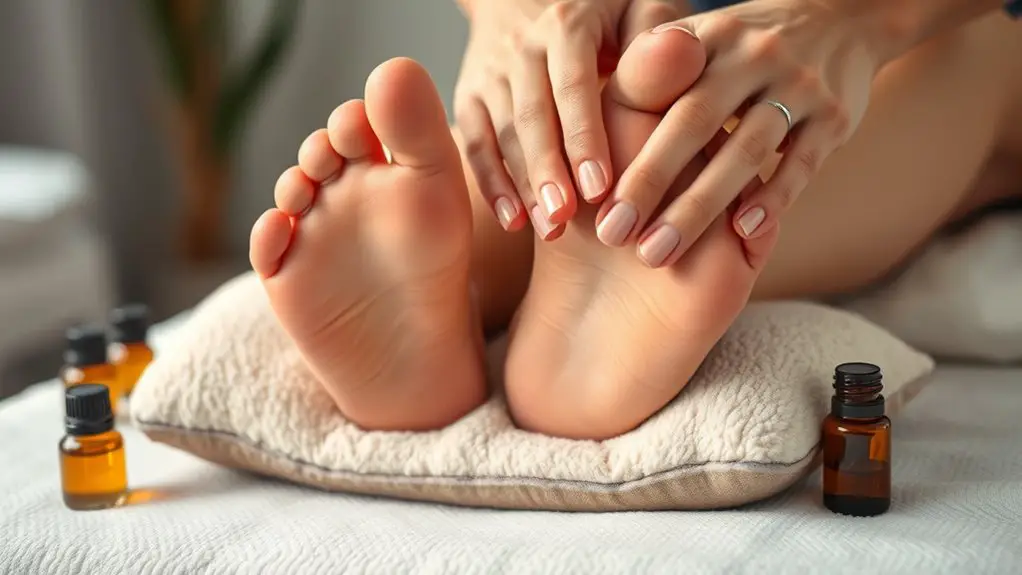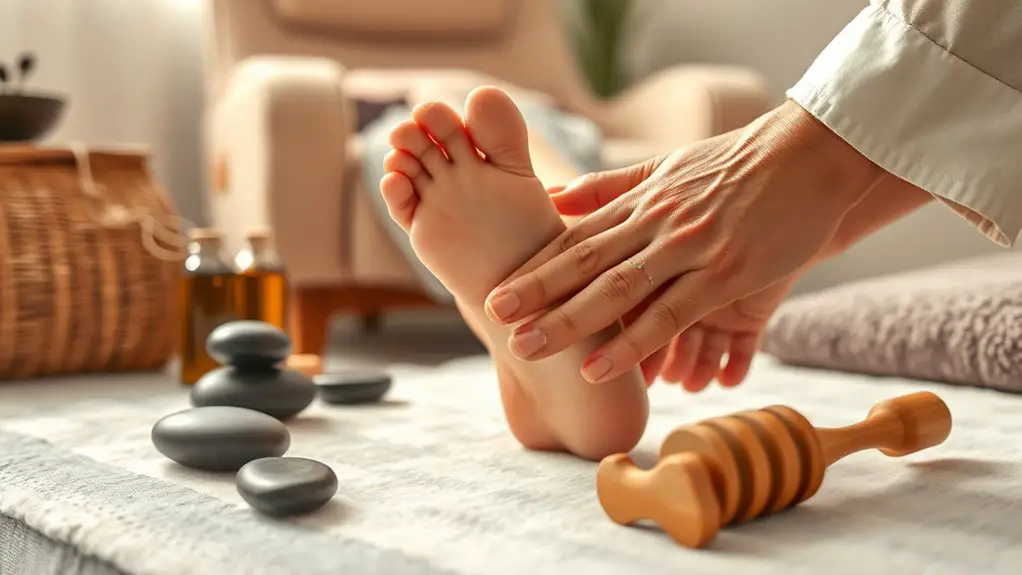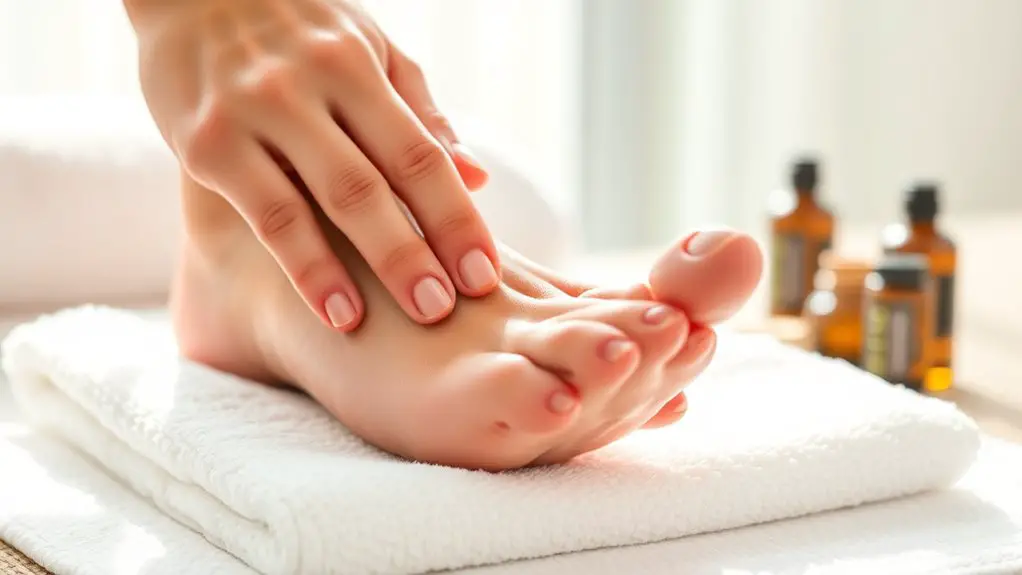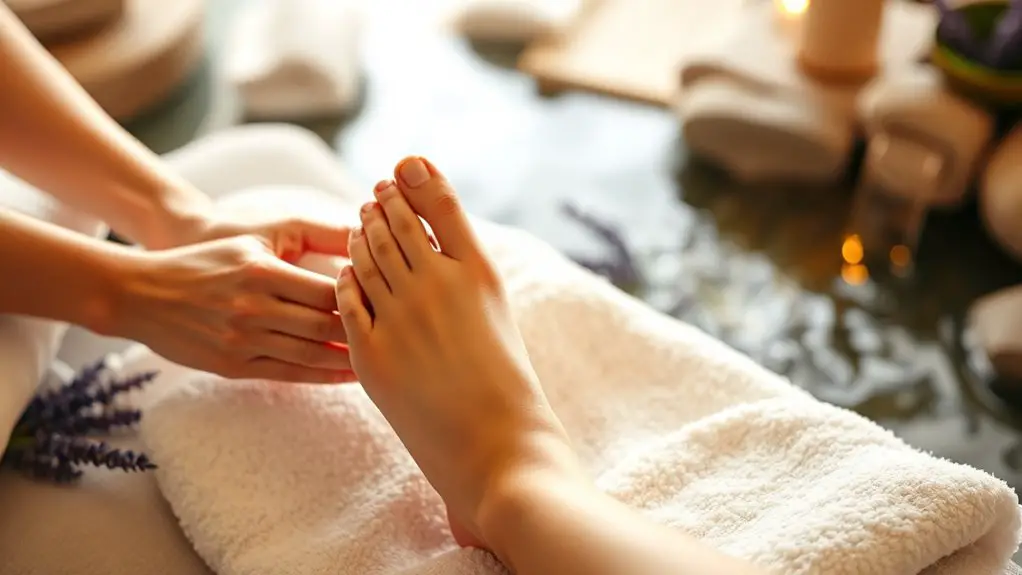If you’re dealing with heel pain, several effective foot massage techniques can help. Deep tissue massage targets deeper muscle layers, while reflexology focuses on pressure points for better circulation. Stretching massage improves flexibility and relaxation, and warm oil massage enhances comfort and pain relief. Each technique can reduce tension and inflammation, promoting healing. To learn more about the essential tools and techniques for foot massage, keep exploring your options for effective heel pain relief.
Understanding Heel Pain: Common Causes and Symptoms

Heel pain is a common complaint that can greatly impact your daily activities. Understanding the causes of heel pain is vital for effective treatment. One prevalent cause is plantar fasciitis, which occurs when the plantar fascia becomes inflamed. Other potential causes include Achilles tendonitis, heel spurs, and bursitis. Each of these conditions can result from overuse, improper footwear, or underlying health issues.
The symptoms of heel pain can vary but often include a sharp, stabbing sensation, particularly with the first steps in the morning or after prolonged sitting. You might also experience swelling or tenderness around the heel area. Identifying the specific symptoms you’re experiencing can aid in diagnosing the underlying cause. If heel pain persists, it’s important to consult a healthcare professional to develop an appropriate treatment plan tailored to your situation. Understanding these aspects will help you manage and alleviate your discomfort effectively.
The Benefits of Foot Massage for Heel Pain Relief
When dealing with heel pain, incorporating foot massage into your routine can provide significant relief. Foot reflexology, a technique that targets specific pressure points, can alleviate discomfort and promote healing. The massage benefits extend beyond mere relaxation; they can enhance blood circulation and reduce inflammation, essential for effective recovery.
| Benefit | Description | Impact on Heel Pain |
|---|---|---|
| Improved Circulation | Enhances blood flow to the foot and heel tissues | Reduces inflammation |
| Pain Relief | Targets pressure points to ease discomfort | Diminishes pain levels |
| Relaxation | Alleviates stress and promotes overall well-being | Enhances recovery speed |
Incorporating regular foot massage can be a valuable component of your heel pain management strategy, aiding not only in pain relief but also in overall foot health.
Essential Tools for an Effective Foot Massage

To maximize the benefits of foot massage for heel pain relief, having the right tools on hand can enhance your experience and effectiveness. The following items are essential for a successful foot massage:
- Massage Oils: Using high-quality massage oils can improve glide and reduce friction, making the massage more enjoyable.
- Foot Rollers: These devices are great for targeting specific areas of discomfort, helping to relieve tension and improve circulation.
- Tennis Ball: A simple yet effective tool for deep tissue pressure, it can be used on the floor or against a wall.
- Warm Towels: Keeping your feet warm can enhance relaxation and improve blood flow during the massage.
- Pillow or Cushion: Elevating your feet can provide comfort and support, allowing for a more effective massage session.
Gathering these tools can greatly improve your foot massage experience and help alleviate heel pain more effectively.
Technique 1: The Deep Tissue Massage
One effective method for alleviating heel pain is the deep tissue massage, which focuses on the deeper layers of muscle and connective tissue. This technique can be particularly beneficial for reducing tension and improving blood flow in your feet. By applying firm pressure, you can target knots and areas of tightness, promoting relaxation and healing.
Here are some massage benefits to contemplate:
| Benefit | Description |
|---|---|
| Pain Relief | Reduces discomfort in the heel and surrounding areas. |
| Improved Flexibility | Enhances range of motion in the foot and ankle. |
| Increased Circulation | Boosts blood flow, aiding in recovery. |
| Stress Reduction | Promotes overall relaxation and well-being. |
| Enhanced Mobility | Facilitates easier movement and daily activities. |
Incorporating deep tissue massage into your routine can greatly enhance your foot health and alleviate heel pain effectively.
Technique 2: The Reflexology Approach

After exploring the benefits of deep tissue massage, another effective method for addressing heel pain is the reflexology approach. This technique focuses on specific pressure points in your feet that correspond to various parts of your body, helping to alleviate pain and promote overall well-being. Here are some reflexology benefits you can expect:
- Reduces tension in the feet
- Enhances circulation to the heel area
- Boosts relaxation and decreases stress
- Promotes healing by stimulating nerve function
- Balances energy levels throughout the body
To practice reflexology, apply firm pressure on targeted areas of your foot, particularly around the heel and arch. By focusing on these pressure points, you can effectively relieve heel pain while enjoying the holistic benefits of this approach. Incorporating reflexology into your routine can be a valuable addition to your foot care regimen.
Technique 3: The Rolling Massage
The rolling massage technique is a highly effective method for relieving heel pain, particularly due to its ability to target tight muscles and fascia in the foot. To perform this massage, you’ll need a small, firm ball, such as a tennis or massage ball. Begin by placing the ball under your foot, positioning it directly beneath the arch. Apply gentle pressure and roll the ball back and forth, focusing on any tender areas. This technique helps to alleviate tension and enhance blood flow, promoting pain relief.
Spend about five to ten minutes on each foot, gradually increasing pressure as tolerated. Be mindful of areas that feel particularly tight; spend extra time on these spots. Incorporating this rolling massage into your routine can greatly improve your foot’s flexibility and comfort, making it an essential addition to your pain relief arsenal. Remember to consult a healthcare professional if pain persists.
Technique 4: The Stretching Massage
Stretching massage can provide significant relief for heel pain by improving flexibility and reducing tension in the muscles and fascia. To maximize its benefits, it’s crucial to employ specific techniques that target the affected areas effectively. This discussion will outline the advantages of stretching massage and guide you through methods to guarantee optimal results.
Benefits of Stretching Massage
A stretching massage can considerably alleviate heel pain by enhancing flexibility and promoting blood circulation in the foot. This technique focuses on dynamic flexibility, allowing for a greater range of motion in the muscles and tendons around the heel. Here are some benefits you might experience:
- Increased flexibility in the foot and ankle
- Reduced tension in the plantar fascia
- Enhanced circulation in the affected area
- Improved overall foot function and mobility
- Decreased risk of future injuries
Techniques for Effective Stretching
While many people overlook the importance of targeted techniques for alleviating heel pain, incorporating a stretching massage can be particularly beneficial. This method combines the advantages of stretching benefits with massage, enhancing flexibility and reducing tension. To perform a stretching massage, begin by gently kneading the heel and arch using your thumbs. Apply consistent pressure while simultaneously stretching the foot by pulling the toes back. Make sure to use proper techniques to avoid injury; maintain a slow, controlled motion. Focus on areas of tightness, holding each stretch for 15-30 seconds. This approach not only promotes relaxation but also improves blood circulation, making it an effective strategy for managing heel pain and encouraging recovery.
Technique 5: The Warm Oil Massage
Five essential techniques can help alleviate heel pain, and one of the most effective is the warm oil massage. This method utilizes the warm oil benefits to enhance circulation and relax muscles, making it particularly effective for heel discomfort. Here’s how to perform this massage technique:
- Choose a suitable oil: Opt for oils like coconut, olive, or essential oils for better absorption.
- Warm the oil: Gently heat the oil to a comfortable temperature; it shouldn’t be too hot.
- Apply the oil: Use a small amount on your hands and rub it into your heel and surrounding areas.
- Use proper technique: Employ circular motions with your fingertips to stimulate blood flow.
- Focus on pressure points: Identify and apply gentle pressure on tender spots to relieve tension.
Incorporating these massage techniques can greatly enhance your comfort and promote healing in your heels.
When to Seek Professional Help
If you’re experiencing persistent heel discomfort, it’s important to contemplate seeking professional help. Additionally, signs of swelling and inflammation or a limited range of motion may indicate a more serious underlying issue that requires medical attention. Addressing these symptoms early can lead to more effective treatment and a quicker recovery.
Persistent Heel Discomfort
Persistent heel discomfort can greatly impact your daily activities, making it important to recognize when professional help is needed. If you’re experiencing ongoing pain, it might signal underlying chronic conditions. Consider seeking medical advice if you notice:
- Persistent discomfort that lasts more than a few weeks
- Pain that interferes with your daily routine or sleep
- Difficulty walking or standing without discomfort
- Symptoms worsening despite home treatments
- A history of foot injuries or conditions
Addressing these concerns early can prevent further complications and help you regain mobility. Don’t hesitate to consult a healthcare professional to evaluate your symptoms and develop a targeted treatment plan tailored to your needs. Your feet are essential, and proper care is important for overall well-being.
Swelling and Inflammation
While some swelling and inflammation in the heel can be a common response to overuse or minor injuries, it’s vital to recognize when these symptoms might indicate a more serious issue. If your swelling persists despite using swelling remedies, or if the inflammation is accompanied by severe pain, redness, or warmth, it’s time to seek professional help. Additionally, if you notice changes in your skin texture or experience difficulty walking, don’t ignore these signs. Effective inflammation management often requires a tailored approach, and a healthcare professional can provide a proper diagnosis and treatment plan. Early intervention can prevent further complications and promote a quicker recovery, allowing you to return to your daily activities without discomfort.
Limited Range of Motion
Experiencing a limited range of motion in the heel can greatly impact your daily activities and quality of life. If you’re facing mobility restrictions or limited flexibility, it’s essential to recognize when to seek professional help. Consider consulting a healthcare provider if you notice:
- Persistent pain despite self-care measures
- Difficulty walking or standing for extended periods
- A noticeable decrease in your foot’s flexibility
- Swelling or inflammation accompanying the limited motion
- Any signs of injury, such as bruising or severe discomfort
Ignoring these symptoms may lead to further complications. A professional evaluation can provide tailored treatment options, ensuring you regain your mobility and improve your overall well-being. Don’t hesitate to seek help when your heel pain hinders your daily life.
Tips for Maintaining Foot Health and Preventing Heel Pain
To maintain foot health and prevent heel pain, it’s essential to adopt a proactive approach to care. Prioritize wearing proper footwear, as shoes with adequate support can greatly reduce strain on your heels. Regular exercise is also vital; it strengthens the muscles surrounding your feet and improves flexibility. Incorporate these preventive measures into your daily routine:
| Tip | Description |
|---|---|
| Proper Footwear | Use shoes with arch support and cushioning |
| Regular Exercise | Engage in activities like walking or swimming |
| Stretching | Perform calf and Achilles tendon stretches |
| Weight Management | Maintain a healthy weight to reduce pressure |
| Foot Hygiene | Keep feet clean and dry to prevent infections |
Frequently Asked Questions
Can Foot Massages Be Harmful for Certain Medical Conditions?
Yes, foot massages can be harmful for certain medical conditions. You should be aware of massage contraindications, especially if you have specific foot conditions like fractures, infections, or severe circulatory issues. Always consult a healthcare professional first.
How Often Should I Get a Foot Massage for Heel Pain?
Think of foot massages as gentle rain on parched soil. For ideal pain relief, frequency recommendations suggest at least once a week. Adjust based on your comfort and response, ensuring your feet stay nourished and rejuvenated.
Are There Any Side Effects of Foot Massages?
While foot massages can improve foot health, potential side effects include bruising, soreness, or allergic reactions to oils used. It’s important to choose appropriate massage techniques and consult a professional if you have concerns.
Can I Perform These Techniques on Myself?
Absolutely, you can perform self-massage techniques as a form of DIY footcare. Just like a sculptor shapes clay, you can mold tension away from your feet, promoting relaxation and enhancing mobility with consistent practice.
What Should I Do if the Pain Worsens After a Massage?
If the pain worsens after a massage, it’s essential to reassess your pain management strategies. Consider modifying your massage techniques, applying ice, or consulting a healthcare professional for further evaluation and tailored recommendations.



